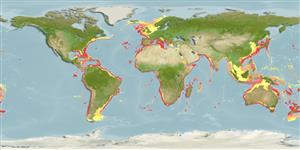Classification / Names
Common names from other countries
Main reference
Size / Weight / Age
Max length : 310 cm TL male/unsexed; (Ref. 247); common length : 200 cm TL male/unsexed; (Ref. 26999)
Length at first maturity
Lm ?, range 200 - ? cm
Environment
Marine; bathydemersal; depth range 10 - 900 m (Ref. 27121), usually 350 - 900 m (Ref. 45445)
Climate / Range
Deep-water, preferred 26°C (Ref. 107945); 72°N - 55°S, 98°W - 173°W (Ref. 54427)
Distribution
Western Atlantic: Virginia, Massachusetts, USA; Venezuela, Argentina. Eastern Atlantic: North Sea to Mediterranean, Morocco to Cape of Good Hope, South Africa. Western Indian Ocean: India, Mozambique, South Africa. Western Pacific: Japan, southern Australia, New Zealand. Records from Oman and Kiribati uncertain. Apparently absent in the Eastern Pacific (Ref. 6578).
Countries | FAO areas | Ecosystems | Occurrences | Introductions
Short description
Dorsal
spines
(total): 0;
Dorsal
soft rays
(total): 0;
Anal
spines: 0;
Anal
soft rays: 0. The bramble shark Echinorhinus brucus has thorn-like denticles on body which are very large (single denticles up to about 15mm in basal diameter in adults), sparse irregularly distributed and thorn-like with smooth basal margins, some bases fused into compound plates. Dorsal surface dark purplish-grey to brown with white denticles, ventral surface paler; sides and back may have dark spots. Tooth count 20-26/21-26.As with the other member of the family Echinorhinidae, it has a relatively short snout and stout body; two small spineless dorsal fins, close together, towards posterior part of body and originating behind pelvic fin origin. No anal fin and subterminal notch on caudal fin. Small spiracles, very short labial furrows and teeth on both jaws alike, with a central oblique bladelike cusps with up to 3 cusplets on each side (absent in juveniles) (Ref. 247, 6871, 5578).
IUCN Red List Status (Ref. 115185)
Human uses
Fisheries: minor commercial; gamefish: yes
More information
ReferencesAquacultureAquaculture profileStrainsGeneticsAllele frequenciesHeritabilityDiseasesProcessingMass conversion
Tools
Special reports
Download XML
Internet sources
Estimates of some properties based on models
Phylogenetic diversity index
PD50 = 1.0000 many relatives (e.g. carps) 0.5 - 2.0 few relatives (e.g. lungfishes)
Trophic Level
4.4 ±0.7 se; Based on diet studies.
Resilience
Very Low, minimum population doubling time more than 14 years (Fec= 15-24)
Vulnerability
Very high vulnerability (85 of 100)
Price category
